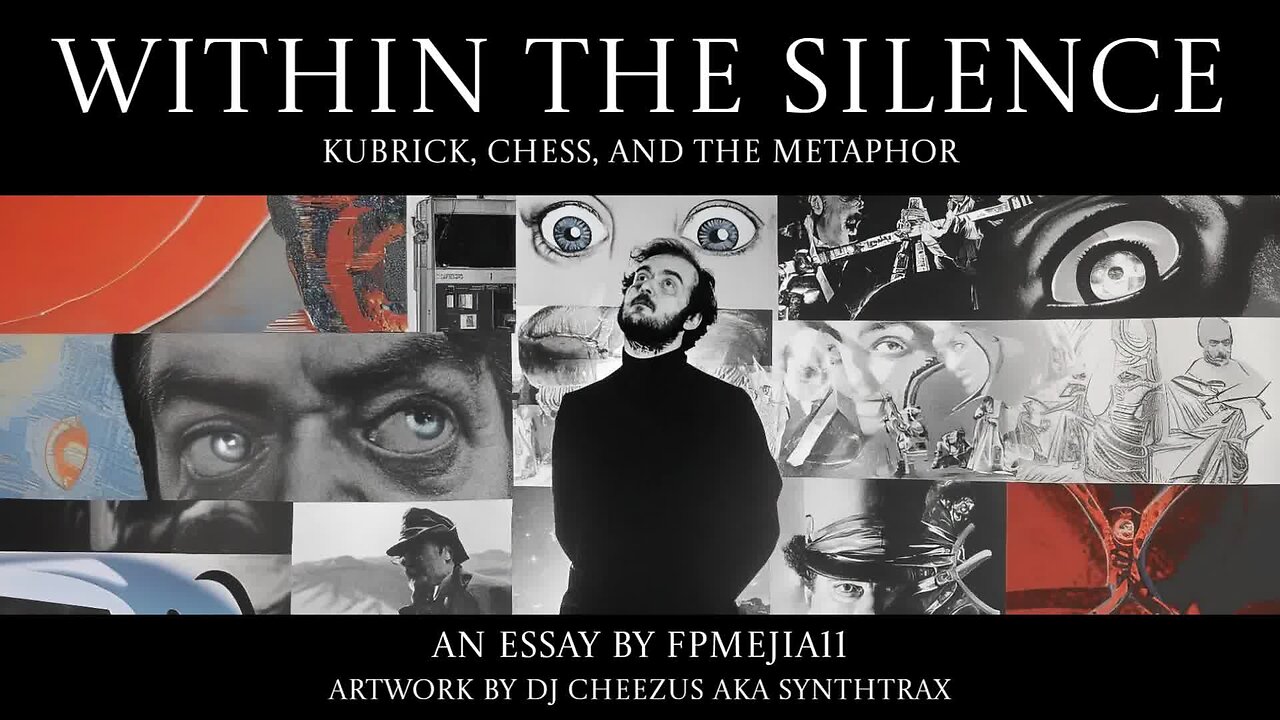Premium Only Content

Within the Silence: Kubrick, Chess, and The Metaphor ...an essay by FPMejia11
Original Essay written by FPMejia11 - https://rumble.com/user/FPMejia11
Original Artwork by DJ Cheezus aka SynthTrax - https://rumble.com/c/DJCheezusLivestreams
Song composed by Philip Glass: Massman - Naqoyqatsi
When a Stanley Kubrick film commences, the screen usually opens up to a bird’s eye view; silent as the letter P in psychology and strong like the Sicilian Defense in a game of chess. Then, with bravado and well thought out strategy the music mingles with the seed being planted. A Kubrick film isn’t transparent in the slightest, although it may appear like a day-dream at first to stupefy us with unanswered questions; we are actually being setup to think how the director wants us to in order to get a certain reaction. The use of the metaphor is Kubrick’s way of explaining something esoteric and subliminal in an evolved way only the over-analyzer would understand. There are complicated actions behind the obvious façade of film that fakes us into believing something with our eyes but is also telling us another story to our unconscious soul. The hidden mechanism inside of us, just like the hidden mechanism of a Patek Philippe timepiece is working in the background of our brains providing us enlightenment unbeknownst to us. I envision Stanley bequeathing us the often-forgotten dreams of his past as they come to fruition in our present tense mind in order to change our future selves.
I can imagine Kubrick wishing our second move be the playful French Defense. Conservative and advantageous as well as drawing us in focally first without having to take much time over-analyzing. Deep in his film’s layers of meaning we find the real art of cinema taking place where there exists a film within a film. Stanley’s gem incarnate is the clandestine Easter egg that is created for epiphanies sake. Before Christopher Nolan’s film Inception arrives in movie theaters in 2010; Kubrick channels this complex phenomenon and plants a subliminal seed of change in film with the purpose of it growing inside of our minds until this plant drops its fruit in our psyche and eventually manifests into our next move.
The shrouded inside of Kubrick’s films, Dr. Strangelove and The Shining go way beyond the obvious connections of the director’s intent. Elaborated patterns emerge undeniably throughout his films like mathematical formulas which explain why godly orbs in the heavens are shaped the way they are. Like God’s omnipotent ways; sacred geometry and the golden ratio coalesce in Kubrick’s expressionisms. The pattern’s purpose in The Shining makes way for countless explanations in our minds; but only Kubrick knows the real reason for them. The game of chess as a metaphor for Kubrick’s films takes control and leads us to an objective truth where imagination is shared by every viewer of his films.
In the game of chess once the two first moves are made; there exists 400 possible board setups. After each of our next moves there will exist 197,742 possible games and after one more set of moves there will be 121 million possible games. What the almost infinite moves of chess has to do with The Shining or Dr. Strangelove is explained in one sentence. First, the more we analyze something the more complicated it gets just like in a Kubrick film and secondly, nothing is impossible when it comes to math; only improbable; just like in a Kubrick film. The seemingly infinite moves in Kubrick’s mind gives way to diminishing returns not when he makes his move; but when you understand why he makes that move. Kubrick checks our king until we finally realize that the check in chess is a metaphor for our own self-consciousness’ internal battle of ego versus logic. The greatest chess game is not against our competitor, it’s the game we play inside ourselves first. Checkmate!
-
 LIVE
LIVE
MattMorseTV
1 hour ago $2.68 earned🔴Trump's Oval Office BOMBSHELL.🔴
1,818 watching -
 18:14
18:14
Real Estate
13 hours agoRising Prices PUSHING AMERICANS OVER THE EDGE
36 -
 1:43:35
1:43:35
Russell Brand
2 hours agoTrump Demands Big Pharma PROVE Covid Vaccine Is Safe – Did Pfizer LIE?! - SF626
106K24 -
 LIVE
LIVE
Due Dissidence
3 hours agoIsrael THREATENS Greta, InfoWars Host QUITS, FL Losing $200M on EMPTYING Alligator Alcatraz
665 watching -

Law&Crime
6 hours ago $0.41 earnedLIVE: Adelson Matriarch Murder Trial — FL v. Donna Adelson — Day 6
2.98K -
 1:08:04
1:08:04
Sean Unpaved
2 hours agoGridiron Shocks: Arch's Rough Start, Belichick's Tar Heel Tumble, & NFL Week 1 Buzz
20.3K -
 LIVE
LIVE
Professor Nez
1 hour ago🚨🇺🇸President Trump makes MAJOR Announcement from Oval Office TODAY!
272 watching -
 1:05:22
1:05:22
Timcast
3 hours agoLiberals Claim TRUMP DIED Or Is Dying And Will RESIGN Today At 2pm
124K107 -
 1:47:55
1:47:55
The Dilley Show
3 hours ago $13.83 earnedChicago in the Crosshairs, Grifters Crash Out and More! w/Author Brenden Dilley 09/02/2025
56.5K6 -
 LIVE
LIVE
StoneMountain64
1 hour agoBattlefield Portal has already been better than I realized
76 watching